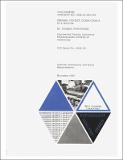| dc.contributor.author | Yovanovich, M. Michael | en_US |
| dc.contributor.other | Massachusetts Institute of Technology. Heat Transfer Laboratory. | en_US |
| dc.contributor.other | Massachusetts Institute of Technology. Engineering Projects Laboratory. | en_US |
| dc.date.accessioned | 2011-03-04T23:36:09Z | |
| dc.date.available | 2011-03-04T23:36:09Z | |
| dc.date.issued | 1965 | en_US |
| dc.identifier | 14135725 | en_US |
| dc.identifier.uri | http://hdl.handle.net/1721.1/61484 | |
| dc.description.abstract | The object of this work is to develop analytically equations by which one could predict the thermal contact conductance between contiguous surfaces operating in a vacuum environment. In this work the solution to the problem is obtained by considering that any surface can be modelled as being either: 1) nominally-flat but rough, 2) a smooth surface having cylindrical waviness, 3) a smooth surface having spherical waviness, or 4) a surface having either cylindrical or spherical waviness plus roughness. Since the radiative heat transfer and the conduction through the interstitial fluid are negligible, the conduction of heat across the metal contact spots is the dominant mechanism. It is considered that the prediction of thermal contact conductance must be approached by: 1) examining the surface geometry, 2) proposing mathematical models for the solution of the heat transfer problem, 3) determining the surface parameters from deformation analysis, and 4) obtaining experimental data to substantiate the proposed models. The surface analysis is actually a critical examination of profiles of real surfaces as obtained by profilometers. From such profiles it is proposed that real surfaces can be idealized by assuming that any surface is a combination of a wavy and rough component. The thermal analysis is based upon the models proposed and the solutions for the steady-state condition are obtained for the various models and the appropriate boundary conditions. Certain surface parameters appear in the thermal contact conductance equations, which require that an analysis of the deformation of the surface under load be undertaken. The deformation analysis is separated into two regimes: 1) purely elastic and 2) purely plastic. The surface parameters are then determined as functions of the applied load for the proposed models under the restrictions of pure elastic or pure plastic deformation. | en_US |
| dc.description.sponsorship | Sponsored by the National Aeronautics and Space Administration DSR | en_US |
| dc.format.extent | vii, 72 [i.e. 102] p | en_US |
| dc.publisher | Cambridge, Mass. : M.I.T. Engineering Projects Laboratory, [1965] | en_US |
| dc.relation.ispartofseries | Technical report (Massachusetts Institute of Technology, Heat Transfer Laboratory) ; no. 39. | en_US |
| dc.subject | Heat -- Conduction. | en_US |
| dc.subject | Vacuum. | en_US |
| dc.subject | Surfaces (Technology) | en_US |
| dc.title | Thermal contact conductance in a vacuum | en_US |
| dc.type | Technical Report | en_US |
